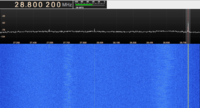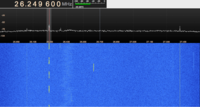Difference between revisions of "User:Kenah/Unravel the Code V"
| Line 59: | Line 59: | ||
====Signals as sounds==== | ====Signals as sounds==== | ||
| − | The last Assignment we got was to look at the sound we found interesting and make something out of it. For me, all the audio signals were just noise. I'm acostumed to listen to music and it has structure en rhythm in it what makes it understandable for me and lets me enjoy it. If I am someone that has that opinion then there will certainly be more on this planet. So I tried to decode de signals by repurposing it to music or at least to the best of my abilities. in the link below you will find my experiment | + | The last Assignment we got was to look at the sound we found interesting and make something out of it. For me, all the audio signals were just noise. I'm acostumed to listen to music and it has structure en rhythm in it what makes it understandable for me and lets me enjoy it. If I am someone that has that opinion then there will certainly be more on this planet. So I tried to decode de signals by repurposing it to music or at least to the best of my abilities. in the link below you will find my experiment. |
[https://drive.google.com/open?id=0B8M1_VWf4lS2RjRRNUR2amtKVDA Soundwaves] | [https://drive.google.com/open?id=0B8M1_VWf4lS2RjRRNUR2amtKVDA Soundwaves] | ||
| − | |||
===MICA Workshop=== | ===MICA Workshop=== | ||
Revision as of 03:56, 1 November 2016
Contents
Unravel the Code V
Interesting works
Human Antenna
What I found interesting about this project, is that is has a whole new way of letting people interact with the installation that is basically a radio. It uses the person and makes it a part of it.
http://www.kraeutli.com/index.php/2009/09/01/human-antenna/
A World Beyond the Loudspeaker
What I found interesting about this project, is that is has a whole new way of letting people interact with the installation that is basically a radio. It uses the person and makes it a part of it.
http://www.evdh.net/awbl/
Immateriality as Material
What I found interesting about this project, is that is has a whole new way of letting people interact with the installation that is basically a radio. It uses the person and makes it a part of it.
http://www.trendhunter.com/trends/immateriality-as-material
Walkthrough
the simplicity is really dope in this project. its just 1500 speakers echt playing a certain frequency of sound. I like the way they let people experience the different octaves of sound.
https://vimeo.com/45225412
An Eerie Geiger Counter Chandelier That Flashes and Clicks When It Detects Nearby Radiation
Just like the Immateriality as Material project, I like the way they found to make radiation visible or noticeable. Also, the cultural relevance of the project is very interesting. It's like a warning and a tribute to the Fukushima Daiichi nuclear disaster
http://laughingsquid.com/an-eerie-geiger-counter-chandelier-that-flashes-and-clicks-when-it-detects-nearby-radiation/
Wallwave Vibrations
I never really see science and art really crossover unless it's an interactive installation with lights and sound and mechanics. that is why I really like this project. making electromagnetic waves, visible through sculpting.
http://www.mymodernmet.com/profiles/blogs/loris-cecchini-wallwave-vibrations-extruding-bodies-sculptures#.V5_m8kpHWbU.pinterest
Analog Sensing Devices
Catching the signals
last year we learned a little bit about electronics and how to make your concepts come to life. But is was nowhere near what we had to do in our first workshop. In this workshop, we had to get a quick understanding of radio waves and how to make a receiver that catches a certain frequency. Me and two other students worked together on an amplified receiver. there was a simpler one but a big part of the group already choose to do it and I also looked at it as a challenge to see if we could figure out how to make it with little understanding of what we were making. The first thing we learned was that de size of the antenna had a big part in what it would receive. The second thing i learned is that soldering and reading schematics is still pretty hard to do right. I made one bad connection and the LED light responded but only if you touched it with your hands. it never responded to the signal. Simon eventually helped us out and then it worked like a charm.
What are radiowaves
In the First real class we had with Roel he showed us how to work with the wiki. After that, we went in deep. Because none of us were really familiar with the science of radio waves (Because the last time we had lessons on it was in the middelbare school), he had to teach us it all over again. he explained what the different wavelengths are and explained more on how broad the radio wave spectrum really is. After that intense class, he gave us our own antenna so we could test it out. After we installed all the software needed I tried getting commercial radio stations to listen to just to test if I understood how it all worked.
Whats can i find in the air
The next class we had with Roel we had to go out en discover other signals and try to identify them. Jeroen and I Wanted to go to a high open area to see what we could find. So we choose to go to the roof of the V&D garage. We managed to get some interesting signals. Even getting one that almost getting a clear reading on a vocal transmission.
Signals as sounds
The last Assignment we got was to look at the sound we found interesting and make something out of it. For me, all the audio signals were just noise. I'm acostumed to listen to music and it has structure en rhythm in it what makes it understandable for me and lets me enjoy it. If I am someone that has that opinion then there will certainly be more on this planet. So I tried to decode de signals by repurposing it to music or at least to the best of my abilities. in the link below you will find my experiment.




